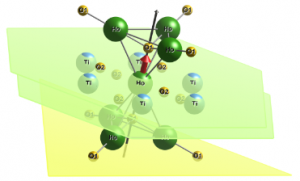Bruno recently posted the first paper resulting from his PhD thesis to the preprint archive. In it we take the first steps towards a micr oscopic view of the magnetic rare earth ions in spin ice, specifically taking into account their quantum-mechanical nature and the effect of crystal electric and magnetic fields. We thus depart from the simplified description of spin ice as a classical Ising system which has served the field so well in the past. This departure is an essential ingredient in the description of spin-flip dynamics and, therefore, of monopole propagation in these systems. Interestingly, the richer description has other consequences, including some curious magnetic anisotropies that might be experimentally observable.
oscopic view of the magnetic rare earth ions in spin ice, specifically taking into account their quantum-mechanical nature and the effect of crystal electric and magnetic fields. We thus depart from the simplified description of spin ice as a classical Ising system which has served the field so well in the past. This departure is an essential ingredient in the description of spin-flip dynamics and, therefore, of monopole propagation in these systems. Interestingly, the richer description has other consequences, including some curious magnetic anisotropies that might be experimentally observable.
Single-ion anisotropy and magnetic field response in spin ice materials Ho2Ti2O7 and Dy2Ti2O7
Motivated by its role as a central pillar of current theories of dynamics of spin ice in and out of equilibrium, we study the single-ion dynamics of the magnetic rare earth ions in their local environments, subject to the effective fields set up by the magnetic moments they interact with. This effective field has a transverse component with respect to the local easy-axis of the crystal electric field, which can induce quantum tunnelling. We go beyond the projective spin-1/2 picture and use instead the full crystal-field Hamiltonian. We find that the Kramers vs non-Kramers nature, as well as the symmetries of the crystal-field Hamiltonian, result in different perturbative behaviour at small fields (≲1 T), with transverse field effects being more pronounced in Ho2Ti2O7 than in Dy2Ti2O7. Remarkably, the energy splitting range we find is consistent with time scales extracted from experiments. We also present a study of the static magnetic response which highlights the anisotropy of the system in the form of an off-diagonal g tensor and we investigate the effects of thermal fluctuations in the temperature regime of relevance to experiments. We show that there is a narrow yet accessible window of experimental parameters where the anisotropic response can be observed.
